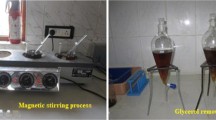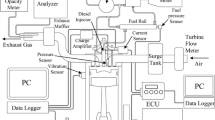Abstract
As the demand for fossil fuels has increased tremendously, cooking oil is found to be an effective source of biodiesel, but storage problems and NOX emissions are the major disadvantages. The current study discusses the effect of natural antioxidant additive Basil on the performance, emission and combustion characteristics of used cooking oil biodiesel in a diesel engine. The Basil powder prepared has been characterized through scanning electron microscopy, Fourier transform infrared spectroscopy, energy-dispersive spectrum and CHNS analysis. Thermal analysis of the prepared Basil particles has been carried out by employing thermal gravimetric analysis and differential scanning calorimetry. The addition of ethanol extracts of the antioxidant increased the oxidation stability measured in terms of the induction period of the biodiesel. The DPPH scavenging activity for the Basil extract increased with concentration, which represents the antioxidant characteristics. The composition of fatty acid and fuel properties of the prepared biodiesel have been determined by means of gas chromatography–mass spectrometry. The antioxidant was added to used cooking oil blend (UCOME20) at a concentration of 500, 1000 and 1500 ppm for which the stability has been determined using zeta potential. The results show that brake thermal efficiency and brake-specific fuel consumption reduced with the addition of antioxidants. NOx emission decreases, whereas hydrocarbon, carbon monoxide and smoke emissions increase. Also, maximum cylinder pressure and heat release rate decreased with the addition of Basil antioxidant to UCOME blend when compared to UCOME20.















Similar content being viewed by others
Change history
23 December 2019
In the original publication of the article, Fig. 15 does not correspond to the variation of heat release rate with crank angle. Moreover, in the results and discussion section, the text included is in reference with Fig. 15.
Abbreviations
- UCOME:
-
Used cooking oil methyl ester
- UCOME20:
-
Used cooking oil methyl ester 20% and diesel 80%
- DPPH 2:
-
2-Diphenyl-1-picrylhydrazyl
- BHT:
-
Butylated hydroxytoluene
- MEBP:
-
Methanol extract of B. purpurea leaves
- DPPD:
-
N,N′-Diphenyl-p-phenylenediamine
- TG:
-
Thermal gravimetric analysis
- DSC:
-
Differential scanning calorimetry
- SEM:
-
Scanning electron microscopy
- FTIR:
-
Fourier transform infrared spectroscopy
- GCMS:
-
Gas chromatography–mass spectrometry
- EDS:
-
Energy-dispersive spectrum
- CI:
-
Compression ignition
- BTE:
-
Brake thermal efficiency
- BSFC:
-
Brake-specific fuel consumption
- CO:
-
Carbon monoxide
- HC:
-
Hydrocarbon
- NOx :
-
Nitrogen oxide
- CN:
-
Cetane number
- ID:
-
Ignition delay
- HRR:
-
Heat release rate
- ppm:
-
Parts per million
- FAME:
-
Fatty acid methyl ester
- FFA:
-
Free fatty acid
References
Patel RL, Sankhavara CD. Biodiesel production from Karanja oil and its use in a diesel engine: a review. Renew Sustain Energy Rev. 2017;71:464–74. https://doi.org/10.1016/j.rser.2016.12.075.
Phan AN, Phan TM. Biodiesel production from waste cooking oils. Fuel. 2008;87(17–18):3490–6. https://doi.org/10.1016/j.fuel.2008.07.008.
Wang Y, Ou S, Liu P, Zhang Z. Preparation of biodiesel from waste cooking oil via two-step catalyzed process. Energy Convers Manag. 2007;48(1):184–8. https://doi.org/10.1016/j.enconman.2006.04.016.
Shahidi F, Zhong Y. Lipid oxidation and improving the oxidative stability. Chem Soc Rev. 2010;39(11):4067–79. https://doi.org/10.1039/b922183m.
Yaakob Z, Narayanan BN, Padikkaparambil S. A review on the oxidation stability of biodiesel. Renew Sustain Energy Rev. 2014;35:136–53. https://doi.org/10.1016/j.rser.2014.03.055.
Monyem A, Van Gerpen JH. The effect of biodiesel oxidation on engine performance and emissions. Biomass Bioenergy. 2001;20(4):317–25. https://doi.org/10.1016/S0961-9534(00)00095-7.
CEN. Fat and oil derivatives—fatty acid methyl esters (FAME)—determination of oxidation stability. Accelerated oxidation test. 2003. https://www.saiglobal.com/pdftemp/previews/osh/is/en/2003/i.s.en14112-2003.pdf.
Tang H, Wang A, Salley SO, Ng KS. The effect of natural and synthetic antioxidants on the oxidative stability of biodiesel. J Am Oil Chem Soc. 2008;85(4):373–82. https://doi.org/10.1007/s11746-008-1208-z.
Tamilvanan A, Balamurugan K, Vijayakumar M. Effects of nano-copper additive on performance, combustion and emission characteristics of Calophyllum inophyllum biodiesel in CI engine. J Therm Anal Calorim. 2018. https://doi.org/10.1007/s10973-018-7743-4.
Murugapoopathi S, Vasudevan D. Energy and exergy analysis on variable compression ratio multi-fuel engine. J Therm Anal Calorim. 2018. https://doi.org/10.1007/s10973-018-7761-2.
Varatharajan K, Cheralathan M. Effect of aromatic amine antioxidants on NOx emissions from a soybean biodiesel powered DI diesel engine. Fuel Process Technol. 2013;106:526–32. https://doi.org/10.1016/j.fuproc.2012.09.023.
Denisov ET, Afanas’ev IB. Oxidation and antioxidants in organic chemistry and biology. Boca Raton: CRC Press; 2005. https://doi.org/10.1201/9781420030853.
Gatial A, Polovková J, Breza M. Quantum-chemical study of N, N-diphenyl-p-phenylenediamine (DPPD) dehydrogenation. Acta Chim Slov. 2008;1(1):72–84.
Varatharajan K, Cheralathan M, Velraj R. Mitigation of NOx emissions from a Jatropha biodiesel fuelled DI diesel engine using antioxidant additives. Fuel. 2011;90(8):2721–5. https://doi.org/10.1016/j.fuel.2011.03.047.
Rashedul HK, Masjuki HH, Kalam MA, Teoh YH, How HG, Fattah IR. Effect of antioxidant on the oxidation stability and combustion–performance–emission characteristics of a diesel engine fueled with diesel–biodiesel blend. Energy Convers Manag. 2015;106:849–58. https://doi.org/10.1016/j.enconman.2015.10.024.
Duarte AM, Aquino JS, Queiroz N, Dantas DL, Maciel GS, Souza AL. A comparative study of the thermal and oxidative stability of Moringa oil with olive and canola oils. J Therm Anal Calorim. 2018;134(3):1943–52. https://doi.org/10.1007/s10973-018-7651-7.
Lima-Corrêa RD, dos Santos Andrade M, Freire JT, do Carmo Ferreira M. Thin-layer and vibrofluidized drying of Basil leaves (Ocimumbasilicum L.): analysis of drying homogeneity and influence of drying conditions on the composition of essential oil and leaf colour. J Appl Res Med Aromat Plants. 2017;7:54–63. https://doi.org/10.1016/j.jarmap.2017.05.001.
Javanmardi J, Khalighi A, Kashi A, Bais HP, Vivanco JM. Chemical characterization of Basil (Ocimumbasilicum L.) found in local accessions and used in traditional medicines in Iran. J Agric Food Chem. 2002;50(21):5878–83. https://doi.org/10.1021/jf020487q.
Shaltout AA, Allam MA, Moharram MA. FTIR spectroscopic, thermal and XRD characterization of hydroxyapatite from new natural sources. Spectrochim Acta A. 2011;83(1):56–60. https://doi.org/10.1016/j.saa.2011.07.036.
Klimankova E, Holadová K, Hajšlová J, Čajka T, Poustka J, Koudela M. Aroma profiles of five Basil (Ocimumbasilicum L.) cultivars grown under conventional and organic conditions. Food Chem. 2008;107(1):464–72. https://doi.org/10.1016/j.foodchem.2007.07.062.
Devi A, Das VK, Deka D. Ginger extract as a nature based robust additive and its influence on the oxidation stability of biodiesel synthesized from non-edible oil. Fuel. 2017;187:306–14. https://doi.org/10.1016/j.fuel.2016.09.063.
Santos BC, Pires AS, Yamamoto CH, Couri MR, Taranto AG, Alves MS, Araújo AL, de Sousa OV. Methyl chavicol and its synthetic analogue as possible antioxidant and antilipase agents based on the in vitro and in silico assays. Oxid Med Cell Longev. 2018. https://doi.org/10.1155/2018/2189348.
Kim SH, Lee SY, Hong CY, Gwak KS, Park MJ, Smith D, Choi IG. Whitening and antioxidant activities of bornyl acetate and nezukol fractionated from Cryptomeria japonica essential oil. Int J Cosmet Sci. 2013;35(5):484–90. https://doi.org/10.1111/ics.12069.
Atadashi IM, Aroua MK, Aziz AA. Biodiesel separation and purification: a review. Renew Energy. 2011;36(2):437–43. https://doi.org/10.1016/j.renene.2010.07.019.
Abed KA, El Morsi AK, Sayed MM, El Shaib AA, Gad MS. Effect of waste cooking-oil biodiesel on performance and exhaust emissions of a diesel engine. Egypt J Petrol. 2018. https://doi.org/10.1016/j.ejpe.2018.02.008.
Jeyakumar N, Narayanasamy B, John K, Kathiresh, Markus Solomon J. Preparation, characterization and effect of calcium carbonate and titanium dioxide nano additives on fuel properties of tire oil diesel blend. Energy Source Part A. 2018;40(15):1798–806. https://doi.org/10.1080/15567036.2018.1486919.
Balaji G, Cheralathan M. The effect of antioxidant additives with methyl ester of neem oil on the oxidation stability. Energy Source Part A. 2016;38(16):2454–61. https://doi.org/10.1080/15567036.2015.1089339.
Narayanasamy B, Jeyakumar N, Saran A, Kumar V. Enhancing the oxidation stability of Mahua oil methyl ester with the addition of natural antioxidants. Energy Source Part A. 2018;40(21):2572–9. https://doi.org/10.1080/15567036.2018.1504146.
Paramasivam B, Kasimani R, Rajamohan S. Characterization of pyrolysis bio-oil derived from intermediate pyrolysis of Aegle marmelos de-oiled cake: study on performance and emission characteristics of CI engine fueled with Aegle marmelos pyrolysis oil-blends. Environ Sci Pollut Res. 2018;25(33):33806–19. https://doi.org/10.1007/s11356-018-3319-x.
Vinukumar K, Azhagurajan A, Vettivel SC, Vedaraman N. Rice husk as nano additive in diesel–biodiesel fuel blends used in diesel engine. J Therm Anal Calorim. 2018;131(2):1333–43. https://doi.org/10.1007/s10973-017-6692-7.
Rashed MM, Kalam MA, Masjuki HH, Habibullah M, Imdadul HK, Shahin MM, Rahman MM. Improving oxidation stability and NOx reduction of biodiesel blends using aromatic and synthetic antioxidant in a light duty diesel engine. Ind Crops Prod. 2016;89:273–84. https://doi.org/10.1016/j.indcrop.2016.05.008.
Qi DH, Chen H, Geng LM, Bian YZ. Experimental studies on the combustion characteristics and performance of a direct injection engine fueled with biodiesel/diesel blends. Energy Convers Manag. 2010;51(12):2985–92. https://doi.org/10.1016/j.enconman.2010.06.042.
Adam IK, Aziz AR, Heikal MR, Yusup S. Performance and emission analysis of rubber seed methyl ester and antioxidant in a multicylinder diesel engine. Energy Fuels. 2017;31(4):4424–35. https://doi.org/10.1021/acs.energyfuels.6b02994.
Karthickeyan V. Effect of nature based antioxidant from Zingiber officinale Rosc. on the oxidation stability, engine performance and emission characteristics with neem oil methyl ester. Heat Mass Transf. 2018;54(11):3409–20. https://doi.org/10.1007/s00231-018-2380-9.
Fattah IR, Masjuki HH, Kalam MA, Mofijur M, Abedin MJ. Effect of antioxidant on the performance and emission characteristics of a diesel engine fueled with palm biodiesel blends. Energy Convers Manag. 2014;79:265–72. https://doi.org/10.1016/j.enconman.2013.12.024.
Fattah IR, Masjuki HH, Liaquat AM, Ramli R, Kalam MA, Riazuddin VN. Impact of various biodiesel fuels obtained from edible and non-edible oils on engine exhaust gas and noise emissions. Renew Sustain Energy Rev. 2013;18:552–67. https://doi.org/10.1016/j.rser.2012.10.036.
Palash SM, Kalam MA, Masjuki HH, Arbab MI, Masum BM, Sanjid A. Impacts of NOx reducing antioxidant additive on performance and emissions of a multi-cylinder diesel engine fueled with Jatropha biodiesel blends. Energ Convers Manag. 2014;77:577–85. https://doi.org/10.1016/j.enconman.2013.10.016.
Prabu A. Performance and emission characteristics of a diesel engine fueled with antioxidants dispersed biodiesel and its blend with diesel. Environ Prog Sustain Energy. 2017;36(2):565–70. https://doi.org/10.1002/ep.12435.
Hasan MM, Rahman MM. Performance and emission characteristics of biodiesel-diesel blend and environmental and economic impacts of biodiesel production: a review. Renew Sustain Energy Rev. 2017;74:938–48. https://doi.org/10.1016/j.rser.2017.03.045.
Sathiyamoorthi R, Sankaranarayanan G. Effect of antioxidant additives on the performance and emission characteristics of a DICI engine using neat lemongrass oil–diesel blend. Fuel. 2016;174:89–96. https://doi.org/10.1016/j.fuel.2016.01.076.
Mofijur M, Masjuki HH, Kalam MA, Atabani AE, Fattah IR, Mobarak HM. Comparative evaluation of performance and emission characteristics of Moringa oleifera and Palm oil-based biodiesel in a diesel engine. Ind Crops Prod. 2014;53:78–84. https://doi.org/10.1016/j.indcrop.2013.12.011.
Devarajan Y, Munuswamy DB, Mahalingam A, Nagappan B. Performance, combustion, and emission analysis of neat palm oil biodiesel and higher alcohol blends in a diesel engine. Energy Fuels. 2017;31(12):13796–801. https://doi.org/10.1021/acs.energyfuels.7b02939.
Jeyalakshmi P. Characterization of Simarouba glauca seed oil biodiesel. J Therm Anal Calorim. 2018. https://doi.org/10.1007/s10973-018-7985-1.
Prbakaran B, Viswanathan D. Experimental investigation of effects of addition of ethanol to bio-diesel on performance, combustion and emission characteristics in CI engine. Alex Eng J. 2018;57(1):383–9. https://doi.org/10.1016/j.aej.2016.09.009.
Author information
Authors and Affiliations
Corresponding author
Additional information
Publisher's Note
Springer Nature remains neutral with regard to jurisdictional claims in published maps and institutional affiliations.
Rights and permissions
About this article
Cite this article
Jeyakumar, N., Narayanasamy, B. Effect of Basil antioxidant additive on the performance, combustion and emission characteristics of used cooking oil biodiesel in CI engine. J Therm Anal Calorim 140, 457–473 (2020). https://doi.org/10.1007/s10973-019-08699-3
Received:
Accepted:
Published:
Issue Date:
DOI: https://doi.org/10.1007/s10973-019-08699-3




